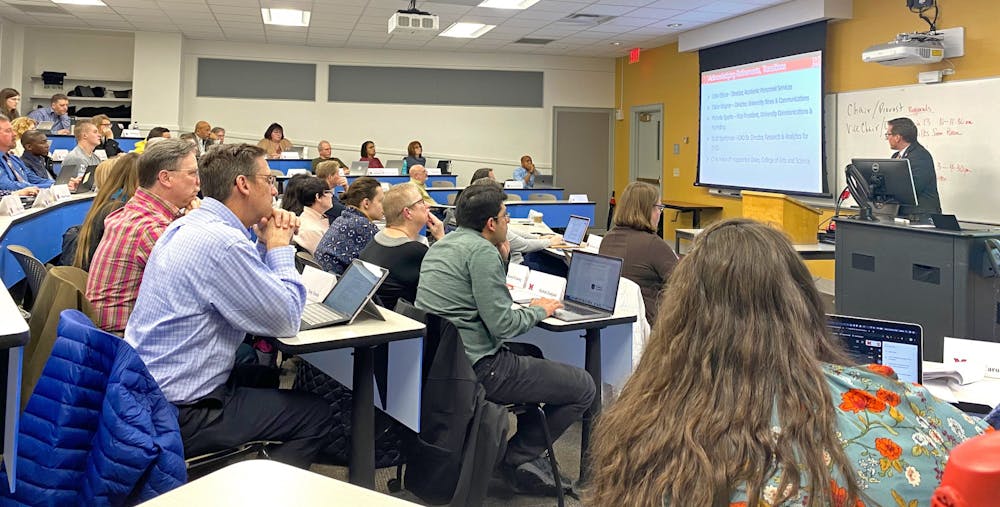Dana Cox, chair of the University Senate Executive Committee, begins each senate meeting with a sharp rap of her gavel on the front table.
The noise instantly brings the room — which was previously filled with chatter and laughter — to attention, and the meeting commences.
University Senate meets every other Monday from 3:30 p.m. to 5 p.m. in Harrison Hall room 111. It consists of more than 70 faculty, staff, students and administrators, and it serves as a place where these groups can come together and discuss policies and issues.
After the call to order, Cox briefly greets everyone, gives a preview of the meeting and makes any relevant announcements. She then invites senate to approve the minutes from the previous meeting and receive the consent calendar, which consists of small items such as committee minutes and reports. By receiving the consent calendar, senate quickly approves these items without discussing them.
Once these housekeeping tasks are completed, senate proceeds with the meeting’s main discussions. Often, these discussions are preceded or accompanied by a presentation from someone who is well-versed in the subject at hand.
Senate’s principle authority lies in educational programs — particularly curriculum — but it also discusses other matters related to student and faculty welfare that are technically outside its purview.
For example, senate originally reviewed and approved a controversial proposed reporting arrests policy that would require faculty to “report any formal police report, arrest, charge or indictment for alleged criminal conduct ... to the Office of General Counsel, within three working days.” Faculty assembly — which consists of all tenure/tenure track faculty, lecturers, clinical faculty and librarians — subsequently voted to send the policy back to senate for reconsideration, and it is still in the process of reviewing it.
Cox said that, though senate only acts in an advisory capacity on matters outside its purview, this arrangement allows senators to discuss and inform their constituents about issues that matter to them.
“Some of the presentations that happen at senate are more informational sessions, and some are where we’re pulling diverse perspectives into a concentrated area and debating these larger [issues],” Cox said.
Faculty senators typically serve three-year terms, whereas student senators typically serve one-year terms. Elections for the following academic year are conducted during the spring semester.
Most senators — 34 total — are divisional representatives. Senate seats are allocated to each division based on the number of faculty in that division. Within each division, a senator represents approximately 24 to 30 constituents — faculty members within the department or departments they represent.
Seats are reapportioned every three years based on changes in faculty distribution. This upcoming year, the College of Arts and Science will lose a seat while the College of Engineering and Computing will gain one.
Enjoy what you're reading?
Signup for our newsletter
Cox, an associate professor of mathematics, represents only her own department, which consists of more than 30 faculty members. But, other senators represent several departments because their home department is too small to have its own representative.
Some of these department groupings make more sense than others. Tracy Haynes, associate teaching professor of biology, represents biology and microbiology, but Chip Hahn, associate clinical professor of speech pathology and audiology (SPA), represents SPA, anthropology, geography and political science.
Hahn said that, when it comes to representing a somewhat-mismatched group of constituents, communication is extremely important.
“If there are [issues] that I think are particularly important, I’m very deliberate in saying [to my constituents] ‘We’re going to be voting on this; I need to know your input,’” Hahn said. “The key is regular communication and making sure that they know I’m approachable.”
Other senators don’t represent particular departments, but rather the faculty as a whole. There are 10 of these “at-large” senators, and they are nominated and voted upon by the entire faculty body.
Rodney Coates, professor of global and intercultural studies, is currently serving in his third and final year as senator at-large. Though he doesn’t represent a specific constituency, he considers himself a representative of Miami’s faculty members of color.
“When you look around [during a senate meeting], how many people of color do you see? Very few,” Coates said. “So one group of people that I certainly feel like I represent are people of color.”
In addition to the faculty members, 13 undergraduate students and two graduate students serve on senate. These students are appointed to senate by Associated Student Government’s chief of staff.
Cox said that it’s rare for Miami’s senate to include students and staff members, as most peer institutions only have faculty senates. Only seven staff members sit on Miami’s senate, and they’re all appointed by the university president.
“In our senate, it’s a global voice,” Cox said. “We have administrators, we have faculty, we have staff and we have students, both graduate and undergraduate. It is a comprehensive body, wherein every person within the Miami community should have a representative.”
Cox especially emphasized the student presence as an important feature of senate.
“I think it’s powerful because, as a student, you have a perspective on who should be teaching your coursework and how it should be taught,” Cox said. “For students to have a voice in the overall curriculum of the university, I think sends a powerful, democratic message.”
Though student senators are able to participate in discussions, they rarely do.
Senior economics and quantitative economics major Sarah Siegel is currently serving in her second semester in University Senate. She said that the reason most student senators don’t talk is because the issues senate discusses are rarely relevant to them.
“There have been very few moments when I’ve felt the need to step in,” Siegel said. “I don’t feel equipped to discuss most issues, and I also don’t feel like they pertain to me.”
Siegel added that senate tends to spend excessive time on certain issues while failing to address others that may be more relevant to students, such as the upcoming census.
“There are a bunch of other issues that pertain more to students that should be brought up, and we students [in senate] need to do a better job of advocating for ourselves and talking about those issues,” Siegel said.
Cox said that she’s aware of the lack of student participation and that, while she understands the reasons behind their silence, she wishes they’d speak up more.
“[The lack of student participation] is a usual thing, and I’m sad about it,” Cox said. “I think that it’s easy for faculty members to dominate, and I think people tend to defer to them, which is unfortunate.”
Though the current senate isn’t perfect, some members say it’s come a long way in the past couple of years.
Scott Kenworthy, associate professor of comparative religion, is in the first year of his current term on senate, but he served another term about 10 years ago.
He said that, back then, senate rarely had critical discussions and, in turn, was not taken seriously by most people on campus. Though this is no longer the case, senate is still fighting to rid itself of that reputation.
“I think the perception that a lot of people have is that senate just tends to rubber stamp whatever is put forward,” Kenworthy said. “But it doesn’t have to be that way, and it isn’t anymore.”
Hahn and Coates both agreed that senate is still actively working to shake its “rubber stamp” label, and both said that a major cultural shift has occurred in the past year or so during Cox’s period of leadership.
Technically, the provost serves as the chair of senate and, historically, has run the meetings.
But, Cox said that current provost Jason Osborne has elected to take a more hands-off approach to his duties as chair. Instead, he shares responsibility of running meetings and leading the group with her.
During meetings, Osborne sits in the back of the room and, though he occasionally weighs in on discussions, his speaking time is generally limited to a 10-minute report toward the end of the meeting.
“[Osborne] said that, democratically, maybe it’s not the provost that should be leading University Senate,” Cox said. “When he sits in the back, he’s making a very political and important statement that the faculty, students and staff should have a strong voice.”
Osborne’s decision to share responsibility of running meetings with Cox reflects a major theme that comes up in nearly every senate discussion: shared governance.
From the policy requiring senate approval for any changes to divisional TCPL caps to the body’s effort to consider all angles of controversial policies, one of senate’s principal functions is to ensure that all members of the Miami community have an equal role in shaping university policy.
Hahn said that, in addition to becoming a more critical and influential body, the level of shared governance exhibited by senate has grown exponentially in recent years.
“It’s not all just top-down — there’s a lot of bottom-up that’s going on as well,” Hahn said. “It’s not your grandpa’s senate.”




